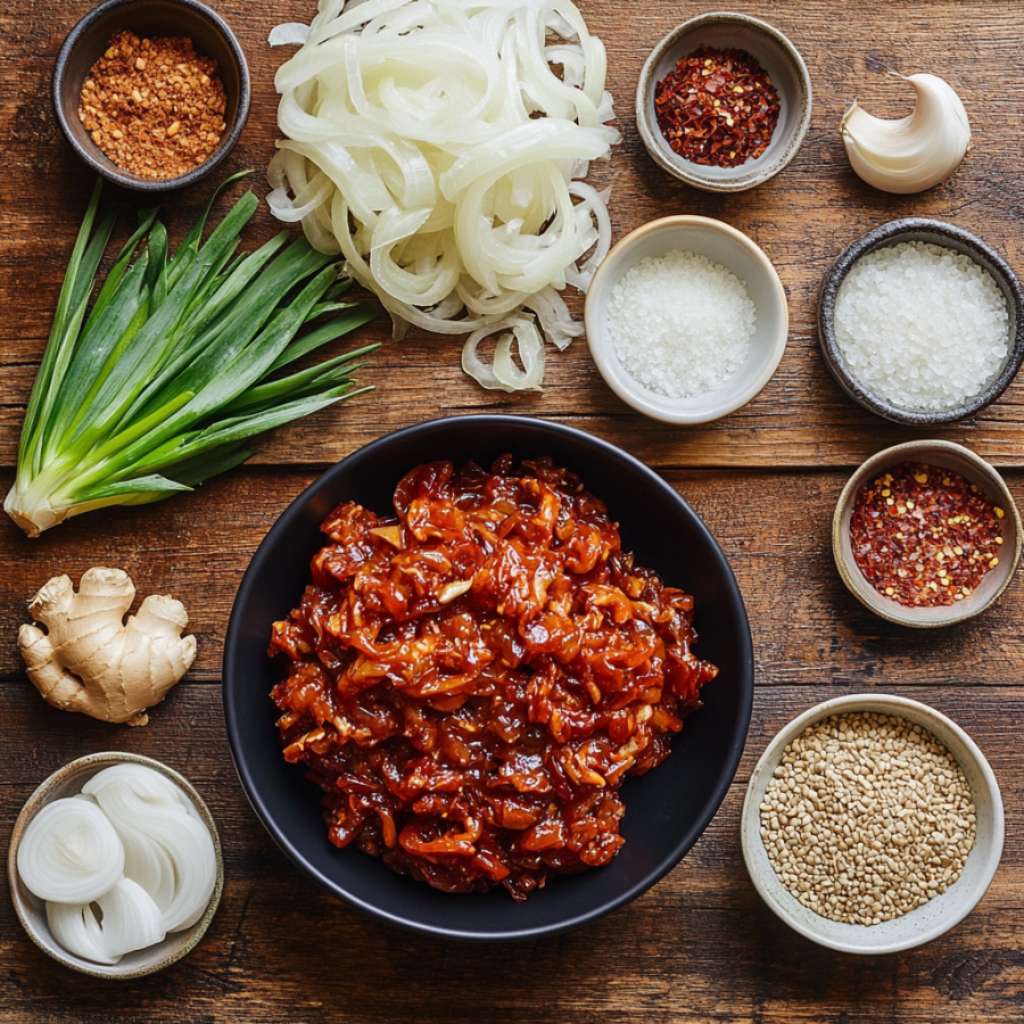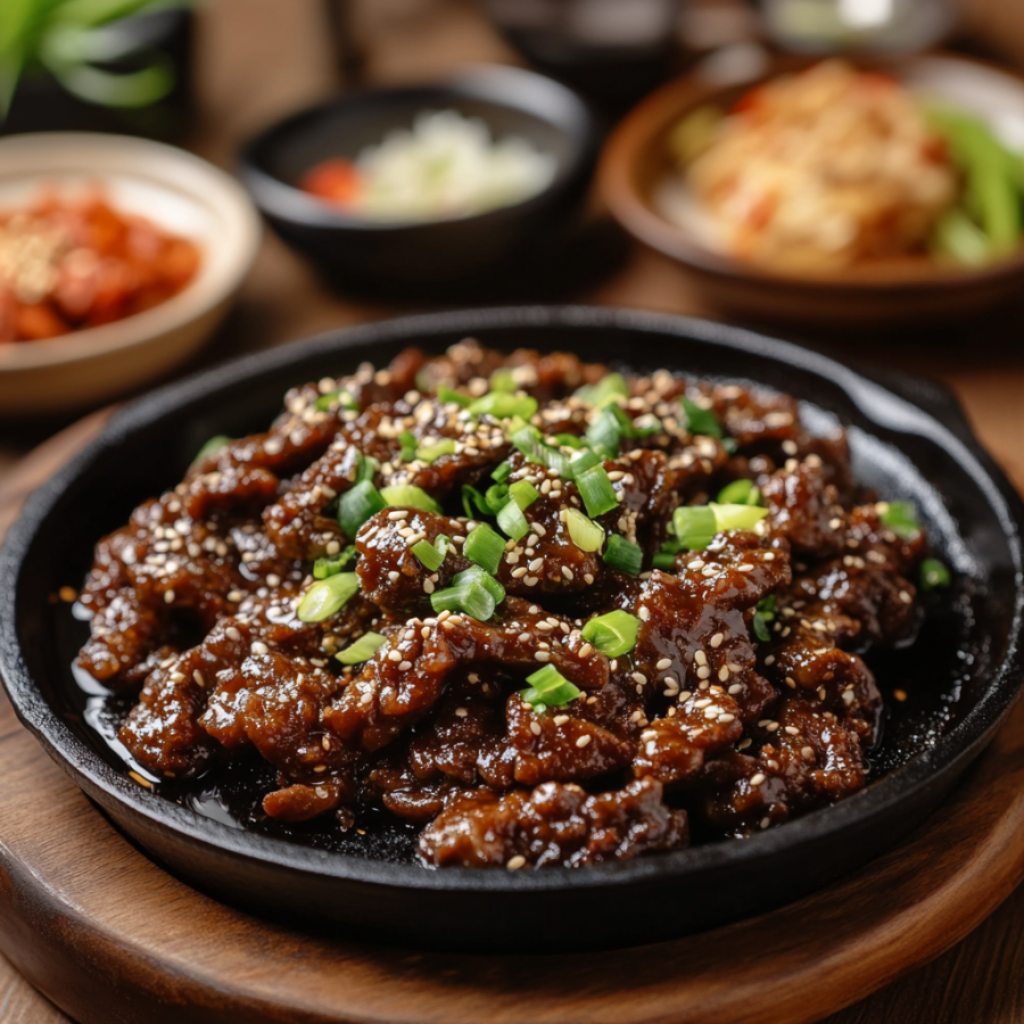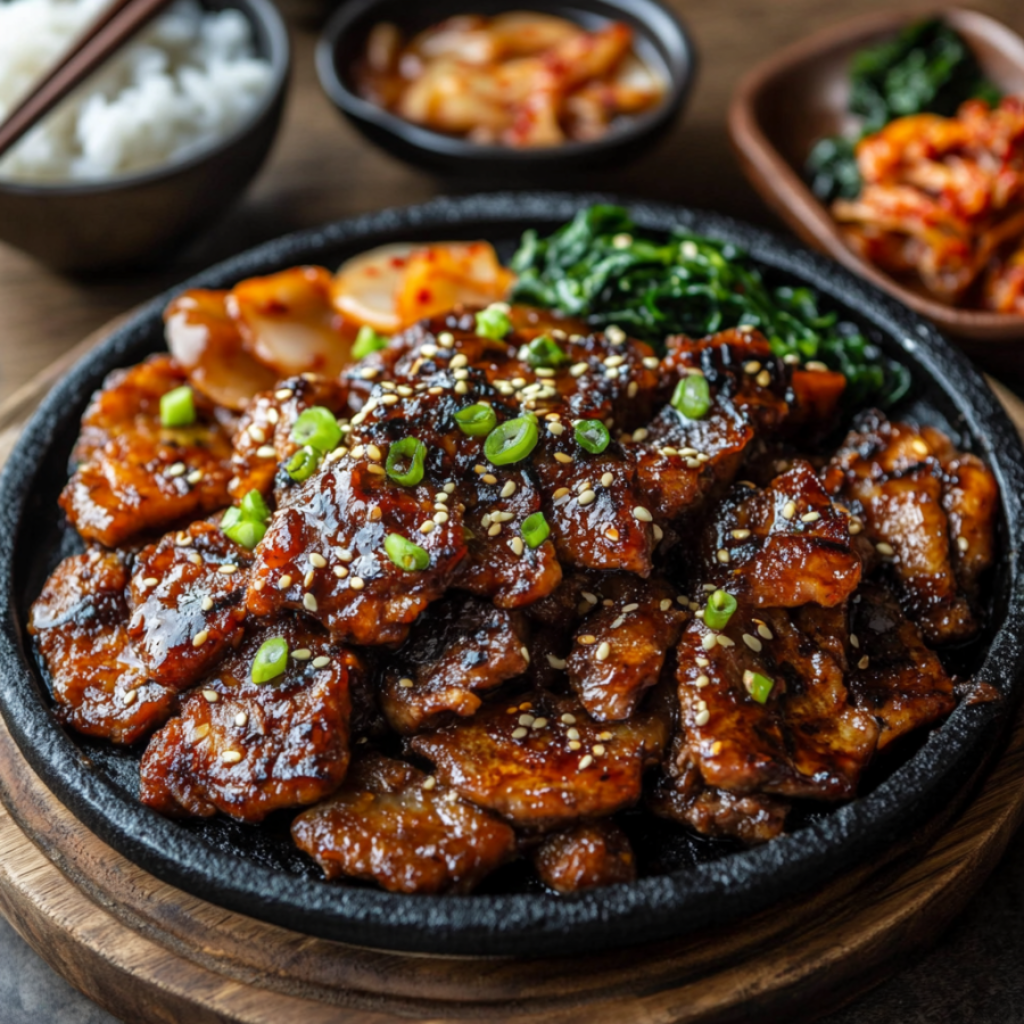Welcome to the world of vegan bulgogi, a tasty twist on Korean BBQ! This recipe uses plant-based ingredients to bring back the tender, savory flavors of traditional bulgogi. It’s perfect for both meat lovers and vegans, offering a bold, umami-rich taste that respects centuries of culinary tradition without animal products.
If you’re new to Korean cuisine or a seasoned cook, this dish is for you. It combines cultural heritage with modern plant-based eating. The recipe uses soy-based proteins like tofu or seitan, marinated in a sweet-soy-garlic blend. This way, it captures the iconic bulgogi experience while celebrating bold flavors.
Key Takeaways
- Vegan bulgogi captures the essence of Korean BBQ with plant-based ingredients.
- Perfect for all diets, from vegan diets to meat-eaters exploring new flavors.
- Uses traditional marinade ingredients like soy sauce, sesame oil, and ginger.
- Easily adaptable with common pantry staples for authentic taste.
- Showcases how vegan cooking can honor global culinary traditions.
What is Traditional Bulgogi and Why Make it Vegan?
Bulgogi has a rich history, moving from royal feasts to vegan kitchens. It’s a dish that blends tradition with innovation. Let’s dive into its story and why vegan versions are popular today.
The History and Cultural Significance of Bulgogi
Bulgogi started in Korea’s Three Kingdoms era. It was made with thinly sliced beef marinated in traditional bulgogi sauce. This sauce mixed soy sauce, sugar, and fruit.
Over time, it became a favorite at markets and family events. As
“Bulgogi connects Koreans to their heritage through taste and ritual,”
historian Kim Hyeon-ju notes. Its flavors hold deep cultural value.
Benefits of Plant-Based Korean Cuisine
Creating vegan Korean food like bulgogi brings many benefits:
- It’s high in fiber and low in saturated fats, unlike meat dishes
- It reduces carbon footprint by 50% compared to beef
- It meets dietary needs while staying true to tradition
This change shows that sustainability and tradition can go hand in hand.
The Flavor Profile of Authentic Bulgogi
Traditional bulgogi’s taste is unique. It combines soy sauce’s saltiness, pear’s sweetness, and garlic’s depth. Plant-based bulgogi uses mushrooms, jackfruit, or tofu to mimic this.
Key flavors include:
- Umami from mushrooms or soy-based proteins
- Caramelized sweetness from fruit-based sauces
- Spice balanced with savory elements
This results in a dish that’s both familiar and new. It honors tradition without giving up on innovation.
Essential Ingredients for Perfect Vegan Bulgogi
Choosing the right ingredients is key to making vegan bulgogi taste like the real thing. Start with the protein: vegan meat alternatives like seitan, soy curls, mushrooms, or jackfruit. Each one gives a different texture and taste.
Ingredients

- 2 cups of soy curls
- ½ medium onion, thinly sliced
- ¼ cup low-sodium soy sauce (use tamari to make gluten-free)
- 3 tablespoons of maple syrup
- 1 tablespoon rice vinegar
- 3 cloves garlic, minced
- 1 teaspoon red pepper flakes
- 1 teaspoon ground ginger
- ½ tsp black pepper
- 1 teaspoon corn starch
- 2 teaspoons Kitchen Bouquet Browning & Seasoning Sauce
The plant-based marinade is made with soy sauce, rice vinegar, sesame oil, ginger, garlic, and gochugaru. An Asian pear adds sweetness and tenderizes the protein. If you can’t find an Asian pear, use an apple or a little honey instead. Gochugaru adds a bit of heat; if you prefer it milder, use paprika. Sesame oil gives a nutty flavor; if you don’t have it, use vegetable oil instead.
| Traditional Ingredient | Substitution |
|---|---|
| Asian pear | Apple or 1 tsp honey |
| Gochugaru | Paprika (omit heat) |
| Sesame oil | Vegetable oil (less authentic but works) |
You can still make delicious Korean vegan cooking at home, even with substitutions. You can find gochugaru or sesame oil online or at Asian markets. Use what you have, but keep the main flavors in mind for the best taste.
How to Make Vegan Bulgogi at Home
Learning to make homemade vegan bulgogi is easy. Just follow these steps to get that tender, savory taste of Korean BBQ without meat.
Preparing Your Plant-Based Protein
Start with firm tofu, mushrooms, or seitan. Cut tofu into thin strips and pat dry. Use thick mushroom slices like portobello or king oyster. Marinate them for at least 30 minutes to soak up flavors.
“Slicing against the grain creates a meat-like texture,” Chef Mia Kim of Seoul Street Kitchen advises.
Creating the Traditional Vegan Bulgogi Marinade
Combine ¼ cup soy sauce, 3 tbsp brown sugar, 2 tbsp rice wine vinegar, 1 tbsp toasted sesame oil, 1 tsp grated ginger, and 2 minced garlic cloves. You can add 1 tsp gochujang for a spicy kick. Let the proteins marinate for 1–4 hours.
Adjust the sweetness by adding less sugar or lime juice.
Vegan Cooking Techniques for Authentic Results
Warm a cast-iron skillet or grill pan. Cook the marinated slices over medium heat until they caramelize, about 5–7 minutes. For a smoky flavor, grill in a basket. Serve with steamed rice and lettuce wraps.
Finish with toasted sesame seeds and scallions for extra flavor.
Troubleshooting Common Issues
- Too soft? Pat proteins dry before marinating and avoid overcooking.
- Too sweet? Balance with soy sauce or add a dash of rice vinegar.
- Lack of umami? Roast garlic and ginger before blending into the marinade.
Follow these steps to make homemade vegan bulgogi that’s just as good as restaurant versions. Try different proteins and adjust the seasonings to your liking!
Serving Suggestions and Side Dishes
Pair your homemade vegan bulgogi with classic Korean side dishes for a vibrant meal. These small plates, or banchan, add texture and flavor. Serve dishes like tangy kimchi, sautéed spinach namul, or sweet-sour pickled radish. Each bite complements the savory marinade of your bulgogi.
- Kimchi: Fermented napa cabbage with chili paste and garlic.
- Japchae: Sweet potato noodles stir-fried with vegetables.
- Pickled cucumbers: Quick-pickled in rice vinegar and sesame oil.
- Muchim: Seasoned spinach with soy sauce and sesame seeds.
For presentation, arrange dishes in small bowls around a shared platter. Serve bulgogi on a heated stone or cast-iron skillet for a true Korean BBQ at home vibe. Wrap slices in lettuce leaves (ssam) with rice and sauce, or layer them into a rice bowl with gochujang paste.
| Beverage | Description | Pairing Tip |
|---|---|---|
| Makgeolli | Sweet rice wine with a milky texture | Blends with spicy flavors |
| Barley tea | Roasted barley infusion | Cleanses the palate between bites |
| Soju | Colorless liquor served chilled | Great with appetizers and shared dishes |
Host a casual gathering by arranging dishes buffet-style. Encourage guests to mix and match components. This communal style honors Korean dining traditions while celebrating plant-based creativity. Every dish works together to create a balanced, satisfying meal that feels authentically Korean.
Variations of Vegan Bulgogi for Different Tastes
Do you love bulgogi but want to try something new? These changes let you keep the dish’s essence while adding your twist. From spicy to quick weeknight meals, there’s a version for every taste.
Spicy Gochujang Vegan Bulgogi
For those who love heat, vegan gochujang recipes are perfect. Add more gochujang to the marinade. Then, balance it with pear juice or brown sugar. A bit of rice vinegar helps tame the chili’s heat.
Serve it with cold sesame seed rice for a spicy yet cool taste.
Gluten-Free Adaptations
Want gluten-free vegan bulgogi? Swap soy sauce for tamari and skip wheat thickeners. Try these:
- Use jackfruit “meat” for a meaty feel
- Thicken with cornstarch instead of flour
- Choose gluten-free rice vinegar
Remember to check labels for gluten warnings.
Quick Weeknight Version
Need a quick vegan meal that’s still fancy? Here’s how to make it fast:
- Grab pre-chopped veggies from the store
- Use pre-marinated tofu or tempeh
- Heat the marinade in the microwave for 2 minutes to tenderize faster
“Tradition isn’t about rigidity—it’s about heart,” says Chef Lee of Seoul Street Eats. “Your changes should honor the dish’s spirit.”
Whether you’re adding spice or cutting prep time, these tips keep bulgogi fresh. Don’t be afraid to experiment. Korean cooking is all about finding the right balance.

Conclusion: Enjoying Your Homemade Vegan Korean BBQ Experience
Now you’ve got the vegan BBQ recipe down. You can enjoy the bold flavors of traditional bulgogi without the meat. Your vegan bulgogi is perfect for a homemade Korean feast, especially with spinach or sweet potatoes.
This dish is more than just a meal. It’s a way to celebrate cultural traditions and plant-based choices.
Sharing this dish with loved ones shows that plant-based eating can be comforting and exciting. Try using jackfruit or tempeh for a twist. Add seasonal veggies like mushrooms to keep things interesting. The goal is to mix bold marinades with tender textures, just like in Korean BBQ.
Whether it’s a dinner party or a quick meal, your kitchen becomes a place to celebrate and innovate. Try new bulgogi vegetables or gluten-free recipes to keep things fresh. Every bite of vegan bulgogi shows that vegan cooking can honor heritage and explore global flavors. Get your grill or skillet ready for your next culinary adventure!
FAQ
What is vegan bulgogi?
Vegan bulgogi is a plant-based version of Korean BBQ beef. It uses ingredients like seitan, mushrooms, or soy curls. A sweet-savory marinade gives it similar flavors and textures, making Korean cuisine accessible to everyone without animal products.
How can I achieve the authentic flavor of bulgogi in a vegan recipe?
To get the real taste of bulgogi, use a balanced marinade. Soy sauce, sesame oil, and gochugaru (Korean chili flakes) are key. Asian pear tenderizes the protein and adds sweetness.
Can I make vegan bulgogi gluten-free?
Yes! Use tamari or coconut aminos instead of soy sauce. Choose gluten-free proteins like jackfruit or tofu for a gluten-free vegan bulgogi.
What are the best ways to serve vegan bulgogi?
Vegan bulgogi is versatile. Serve it in ssam (lettuce wraps), with kimchi or seasoned vegetables, or in a bibimbap-style rice bowl. Refreshing barley tea is a great drink to pair with it!
Can I make vegan bulgogi ahead of time?
Yes, you can prep the marinade and protein ahead. Marinating a few hours before cooking boosts flavors. Cooked bulgogi keeps well in the fridge for a couple of days, perfect for quick meals.
What other variations can I try for vegan bulgogi?
Try a spicy gochujang version for those who like it hot. Or, make a quick version using pre-packaged veggies and marinades. These options let you tailor the dish to your taste and schedule.

